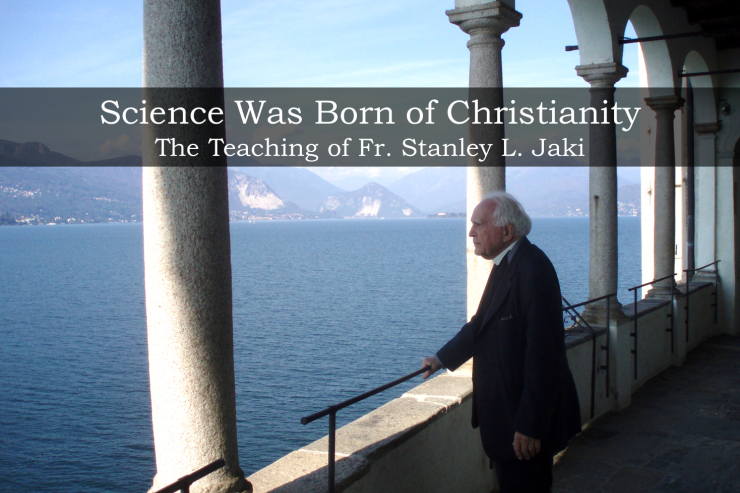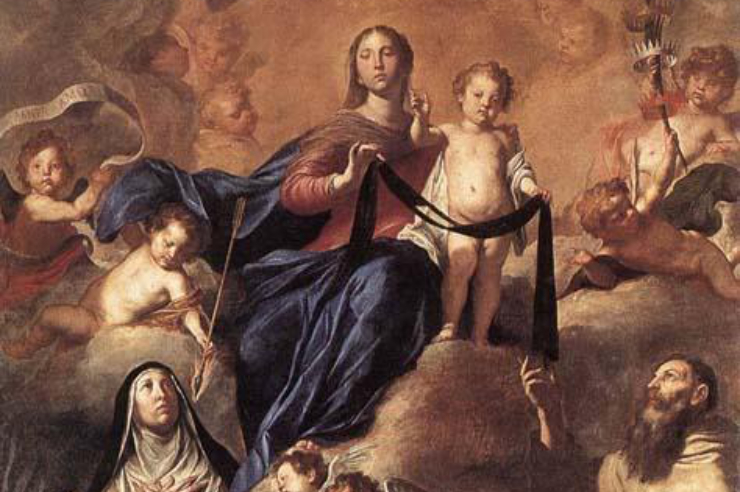This is the final of a six-part series on the teaching of Fr. Stanley L. Jaki. To understand how science was born of Christianity, it is helpful to first understand “Fr. Stanley Jaki’s Definition of Science” and “The Stillbirths of Science in Ancient Cultures.” By science Fr. Jaki meant what we now call “modern science,” which is the application of mathematics to observations to develop physical laws. The third essay, “The Radical Scientific View of Biblical Cultures,” showed how the biblical and early Christian world view was conducive to the birth of exact science and radically different from other ancient world views. The fourth essay, “The Christian Middle Ages and the Greek Scientific Corpus,” reviewed the writings of scholars of the Middle Ages and showed how Christianity purified the Greek scientific corpus, breathing the first breaths of life into into what would become a viable discipline. The fifth essay, “Fr. Jean Buridan’s Impetus Theory,” presented the work of the French priest who developed the concept of the impetus which led to the modern concept of inertia and paved the way for Isaac Newton’s first law of motion. This last essay puts it all together and explains why science was born of Christianity.
Following the Condemnations of 1277 by Tempier against a set of tenets upheld by Aristotle and his followers, a large movement appeared that liberated Christian thought from the ancient Greek thought and produced modern science. Pierre Duhem (1861–1916), whose work Jaki studied and expanded upon, identified the 1277 articles as the most significant event in the birth of modern science whereas Jaki highlighted the spark ignited by Buridan a generation later. For Jaki, however, it is not a certain man, event, or date that marks the birth of science; it was a breakthrough in a naturalistic worldview that rejected the pantheistic doctrine of eternal cycles and approached the investigation of nature guided by the light of Christian faith.
Jaki referred to Buridan’s essay on impetus theory as the “most important passage ever penned in Western intellectual history as far as science is concerned.”[1] Buridan was of course not the first Christian to oppose Aristotle on the eternity of the world. The Fourth Lateran Council in 1215 codified the dogma that there is “only one true God, eternal and immeasurable, almighty, unchangeable, incomprehensible and ineffable, Father, Son and holy Spirit, three persons but one absolutely simple essence, substance or nature . . . one principle of all things, creator of all things invisible and visible.”[2] The Condemnations of 1277 in the generation preceding Buridan identified Aristotle’s errors contrary to the Christian dogma and affirmed the dogmas of creation out of nothing and a beginning in time.
Buridan was not a theologian but a man with a brilliant scientific mind concerned with explaining observations of moving objects that were unsatisfactorily solved by Aristotle. His assent in faith to the tenets of the Christian Creed guided him to assert the most critical breakthrough in the history of science, the idea of inertial motion and impetus.[3] Buridan became the rector of the University of Paris in 1327 and taught there until about 1360. In 1377, his theory was formally proposed by Nicole Oresme (1320–1325) and was destined to be adopted by Albert of Saxony (1316–1390), Nicolaus Copernicus (1473–1543), Galileo Galilei (1564–1642), and Sir Isaac Newton (1642–1727). As has, in fact, occurred since the time of Buridan, physics has grown exponentially with new insights, understandings, capabilities, and realms of observation and measurement at almost unimaginable scales of minuteness and grandeur. Physical science became a universal, viable discipline.
One may wonder how the Jewish or Muslim monotheism is any different from the Christian monotheism and therefore wonder why science was not born in those cultures. Like Christians, the Jewish and Muslim scholars held a monotheistic belief that God created everything in the beginning. However, they were unable or unwilling to break from Aristotle’s pantheistic doctrine of motion. Aristotle’s explanation of motion was based on the doctrine of eternal cycles and returns (pantheism). The Christian scholars, in contrast, did break from pantheistic doctrine, as evidenced in the Condemnations of 1277 and all the debates leading up to them and following them.
Why Christians and not Muslims? The answer to that question is striking. There was too great a separation of philosophy from theology among the Muslim scholars. The philosophers held to Aristotle’s teaching on physical motion, which was based on pantheism, even though the philosophy contradicted Muslim theology. Rather than rejecting the eternity of the world, they tried to find ways to keep the Aristotelian doctrine and explain it.
This idea of eternal cycles had, as Jaki put it, a “stranglehold” on ancient cosmology and those who accepted its orthodoxy.[4]
Some of the Greeks viewed the universe as having a beginning, but it was not an absolute beginning like the absolute beginning in time in the Bible. According to Aristotle and the ancient Greeks, the universe emanated from the First Cause, which was eternal. The beginning of a cycle was taken for a beginning in time but this beginning was believed to be preceded by the end of the previous cycle. The monotheism of the Jews and the Muslims perhaps too easily accommodated by this concept of emanation and cyclic beginnings. But Christian monotheism could not—for to do so would directly contradict the Christian dogmas of the Incarnation and the Holy Trinity. This difference requires further emphasis.
First, the distinction between a Creator and creation is most important. It is the distinction between the act of Creation out of nothing and natural change, the processes that occur in already created things. Creation out of nothing is not a process with a beginning, middle, and end. It is a simple reality of all existence completely dependent on God. This distinction was clarified by Aquinas, who was canonized by the Church in 1322 when Buridan was a young man.[5] This distinction between the act of Creation ex nihilo and causation can be found in other theological sources, including Tertullian (156–230) and St. Augustine (354–430), in the early Church. It was also prevalent in the Old Testament, where it was first mentioned. This distinction is not found in the writings of Jewish and Muslim medieval scholars, hence the conclusion that they were less ready to see how an eternal universe contradicted Scripture.
Second, this distinction between the Creator and creation is owed to the unique Christian monotheism, which is a Trinitarian and Incarnational. There is a major difference in Christian monotheism and Jewish or Muslim monotheism. To grasp the significance of Buridan’s breakthrough, the Trinitarian and Incarnational aspect of Christianity must be appreciated. The birth, life, death, and resurrection of Christ taught the reality of the Trinitarian nature of God and the divinity of Christ. God is one God in three Persons, the Father, the Son, and the Holy Spirit. Christ is the Second Person of the Holy Trinity, the Son, who became man. Therefore, Christ is also the Creator. Christ is also called the Word and the Logos, which explains why there is order and predictability in physical laws created by this personal and merciful God. The Jewish and Muslim faiths do not acknowledge Christ or the hand of God in salvation history. Without the dogma of the Holy Trinity and the Incarnation, there is not much to save monotheism from the errors of pantheism. There is a certain scientific significance in the beginning of St. John’s gospel.
“At the beginning of time the Word already was; and God had the Word abiding with him, and the Word was God. He abode, at the beginning of time, with God. It was through him that all things came into being, and without him came nothing that has come to be. In him there was life, and that life was the light of men.”[6]
The fruits of Christ’s divinity certainly have been relevant for this world, and those fruits include the scientific aspect of history. But the main lesson of that divinity is that it points to a world beyond this world, beyond the cosmos, beyond the universe. The final reminder here is important. It is a reminder that the questions religion can answer are far more important questions to humanity than the questions science can answer. Nonetheless—if one is in agreement with the facts of the late Fr. Stanley Jaki’s research and teaching—it can be asserted with demonstrated confidence that for physical sciences to be born, the supernatural revelation guarded by the Catholic Church was needed. We owe our gratitude to Fr. Jaki for teaching us this heritage.
“There had to come a birth, the birth of the only begotten Son of the Father as a man, to allow science to have its first viable birth.” —Fr. Stanley Jaki [7]
Notes
[1] Stanley L. Jaki, A Mind’s Matter: An Intellectual Autobiography (Grand Rapids: William. B. Eerdmans Publishing Co., 2002), 49.
[2] Fourth Lateran Council, 1215, paragraph 1, see DS, 800.
[3] Jaki, A Late Awakening, 50.
[4] Jaki, A Late Awakening, 52.
[5] Jaki, A Late Awakening, 55.
[6] Knox, John 1:1-5.
[7] Jaki, A Late Awakening, 60.
Photo: The picture was taken from Santa Caterina del Sasso, on the Lake Maggiore, and provided by Fr. Jaki’s friend, Antonio Colombo.
Click here to receive these essays by email. Say hello to Stacy on Twitter or Facebook.















